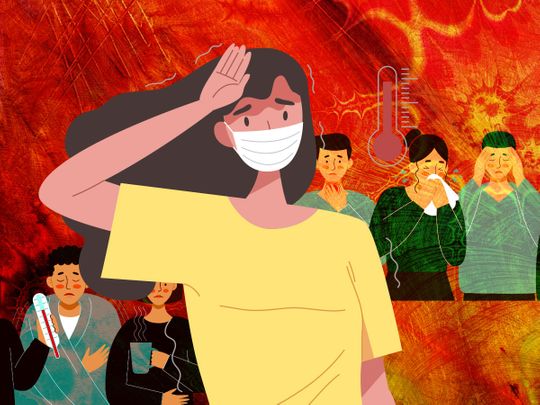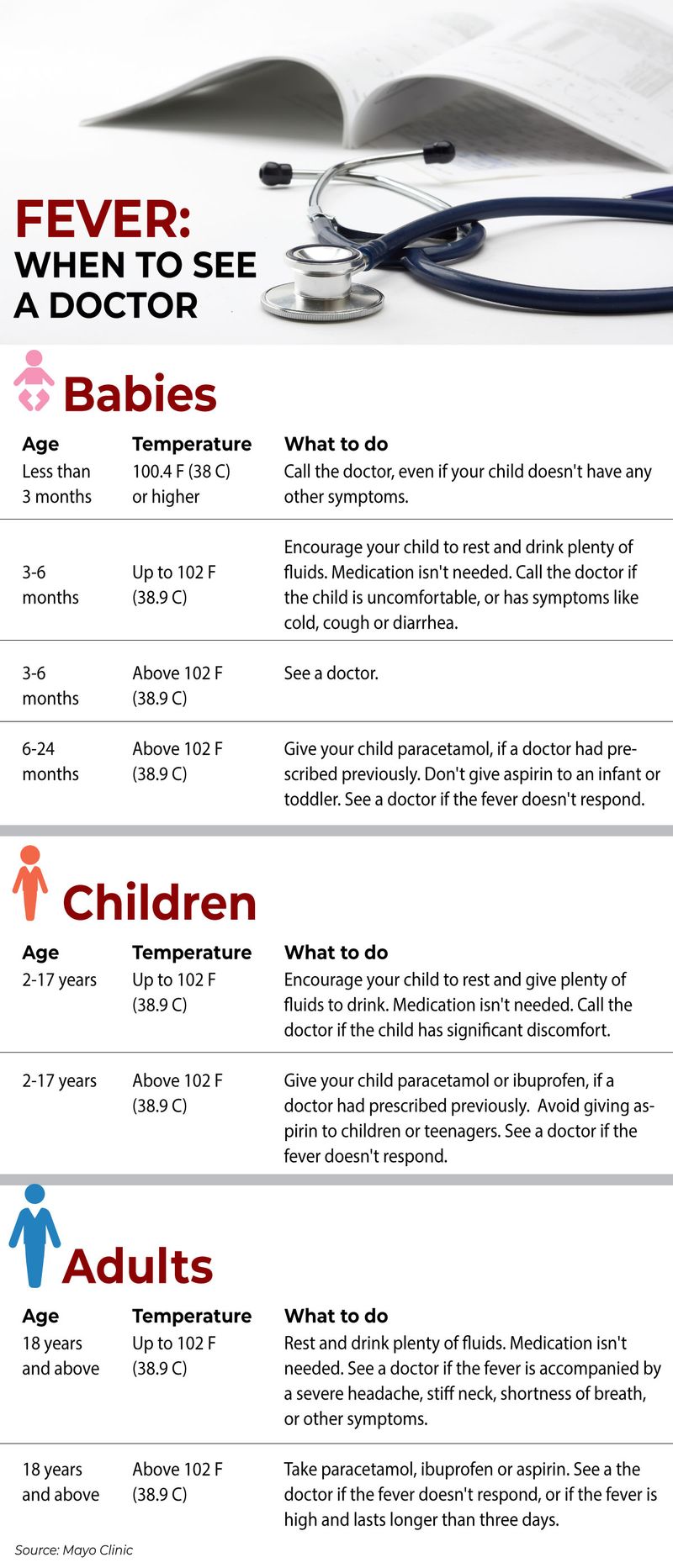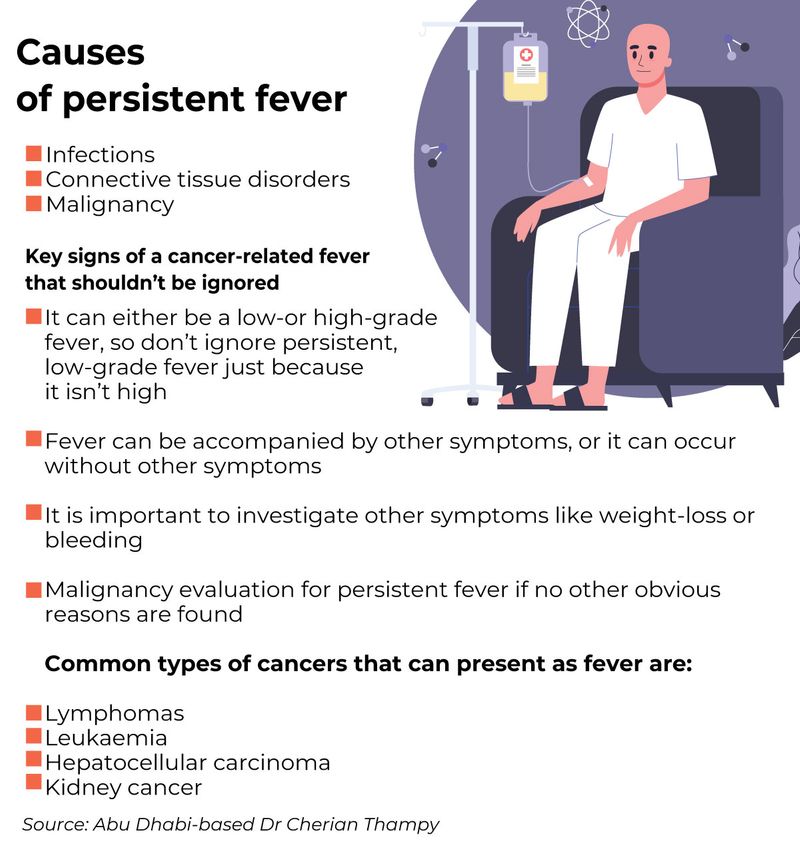
When we have a fever, the body burns, severe headaches and chills follow. What do we do? Pop paracetamol and slip under the blanket. It usually helps. In a day or two, we are back on our feet.
Fever is a minor irritation to most people. But for others, it can be a nightmare. Nausea, vomiting, dizziness, weight loss and several other scary symptoms make their lives miserable. It can be the start of endless hospital visits and a terrifying diagnosis. COVID-19 is just one of them.
So a fever need not be just a fever. It can be more than just an infection. Fever is merely a sign that all is not well with the body.
Rachna [name changed], an expatriate woman in her fifties, came down with a fever in Dubai. The fever lasted a month. It took another month to discover the cause. And that required consultations with eight doctors: three internal medicine specialists, a gastroenterologist, a rheumatologist, an oncologist, a pulmonologist and an ENT surgeon.
It also called for two spells of hospitalisation and several rounds of blood tests, a chest X-ray and numerous scans, including several CT scans, a PET scan and many ultrasound scans (sonography). Three courses of antibiotics and a course of steroids were unable to rein in her fever.
Read the full story: Indian expat woman battles mystery fever for 30 days
Pregnant patient with persistent high fever in Dubai
A patient who suffered persistent high fever was referred to Dr Manish Rastogi from a clinic in Dubai. Around six months pregnant, the patient’s high fever had not responded to medication even after a week. She was frequently urinating, and her lab reports didn’t indicate the cause; only her C-Reactive Protein (CRP) was high, said the internal medicine specialist at NMC Royal Hospital, Dubai Investment Park.
When the fever persisted even after administering antibiotics (intravenous), she was given antipyretics (drugs used to prevent or reduce fever) round-the-clock. Soon, she also developed diarrhoea. Tests for clostridium and other inflammatory bowel diseases returned negative, the doctor said.
More tests were done: influenza, dengue, malaria and typhoid were ruled out. Dr Rastogi said extensive tests for pyrexia (fever) too failed to help arrive at a diagnosis.
Six days after she was admitted to the hospital, the patient developed mild cough and breathlessness on exertion, and there were few respiratory issues. Finally, a chest X-ray with an abdominal shield revealed bilateral pneumonitis (a serious infection that can inflame and scar lungs). The antibiotic was changed, and her body responded. The fever subsided, her condition improved, and she was discharged soon, Dr Rastogi said.

Elderly woman with high fever
An elderly woman with a history of hypertension, hypothyroidism, parkinsonism, and dementia was rushed to the hospital with drowsiness. She had an occasional fever but it was not severe initially.
Her counts were normal with mild elevation of C-Reactive Protein (CRP). “Electrolytes showed hyponatremia. CT was normal. Drowsiness improved on correction of electrolytes,” Dr Rastogi said.
After four days, the drowsiness returned, and the patient developed a persistent fever. “Total leucocyte count was elevated, and CRP was high. Chest X-ray and other investigations were normal.” Finally, she was found to have developed an abscess (a collection of pus, usually caused by a bacterial infection) in the foot, which was triggering the fever.
A change of antibiotic brought improvement, and the patient was discharged, Dr Rastogi said.
What’s a fever?
A fever is generally a short-term increase in body temperature. It’s a common sign of illness, an indication that the immune system is fighting an infection. Normal body temperature ranges from 97°F to 99°F (36.1°C to 37.2°C), a reading above this indicates a fever.
In infants and children even a slight fever may be a sign of a serious illness, but in adults a fever is not usually serious or life-threatening, according to the Mayo Clinic in the US. Fevers tend to go away within a few days, but they indicate a severe health condition if it persists.
What are some of the main symptoms?
- High temperature (above 100.4°).
- Chills, shivering, shaking
- Body pains and headaches
- Fatigue or weakness
- Intermittent or constant sweating
- Decreased appetite
What are the different types of fevers?
A normal body temperature is approximately 98.6°F (37°C), but it may change depending on the time of day, level of physical activity, age, sex and race, site of temperature measurements, reading method, among others. The more accepted normal body temperature is between 97°F and 99°F (36.1°C and 37.2°C). A reading above is considered a fever, and there are different levels of fever severity.
Low-grade fever: Between 98.6°F (37°C) to 100.4°F (38°C)
Moderate-grade fever: Between 100.4°F (38°C) to 102.2°F (39°C)
High-grade fever: More than 102.2°F (39°C)
Hyperpyrexia: A temperature reading at or above 104°F (40°C) is called hyperpyrexia. It is considered a medical emergency that requires immediate care.
What are the common causes of fever?
A fever has many causes and it can be a symptom of any illness. The most common causes listed by the University of Pittsburgh Medical Centre are:
- Colds and flu
- Strep throat
- Ear infections
- Sinus infections
- Bronchitis
- Pneumonia
- Skin infections
- Bladder and urinary-tract infections
- Appendicitis
- Blood clots
- Rheumatoid arthritis
- Lupus
- Inflammatory bowel disease
- Cancer, especially lymphoma and leukemia
- Food poisoning
- Heat exhaustion
- Inflammation (from conditions like rheumatoid arthritis)
- Malignant tumour
- Teething (in children)
- Immunisations (in children)
- Febrile seizures (in children)
- Hyperthyroidism
- COVID-19
When is a fever considered serious?
A high-grade fever (above 103°F or 39.4°C) is serious. It’s time to get emergency medical help. Some signs of serious illness listed in the Healthline are:
- Severe headache
- Dizziness or loss of consciousness
- Sensitivity to bright light
- Stiff neck or neck pain
- Skin rash or hives
- Breathing difficulty
- Frequent vomiting
- Dehydration
- Stomach pain
- Muscle cramps
- Confusion
- Seizures or convulsions
- Hallucinations
- Swelling in any part of the body
Other signs that can be:
- Pain while urinating
- Not urinating enough
- Passing dark urine
- When urine odour is very bad
Fever of unknown origin
A fever that lasts for 10 to 14 days can be defined as persistent fever, according to Abu Dhabi-based Dr Cherian Thampy. “Clinicians commonly refer to fever without an initially obvious aetiology [etiology] or without localising signs as fever of unknown origin. We should address seriously any persistent fever which is not responding to initial treatment,” cautioned the oncology specialist at NMC Specialty Hospital, Abu Dhabi.
Should we be worried if fever persists in children?
“You should consult a doctor if your baby is less than three months old and has a fever; if fever lasts for over five days; if the temperature is over 40 degree Celsius and does not reduce with medications, or if your child develops any red flag signs like poor feeding, is drowsy or has a change in colour of skin,” said Abu Dhabi-based paediatrician Dr Praveen Sreekanthalal.

What is the difference in fever in children and adults?
Unlike adults, children may not explain their symptoms associated with high fevers, Dr Praveen Sreekanthalal said. “Fever in children may not always show the severity of the infection. For example, newborn infants with bacterial infection may not present with fever, they rather present with low-body temperatures. Some children are at risk of developing convulsions from fever unlike adults,” Dr Sreekanthalal said.
“Most common causes of fever in children are upper respiratory tract infections and gastroenteritis. In adults the root cause of a fever could be because of a wide variety of infections, which can be complicated by pre-existing morbidity including diabetes, and for patients who take immune-suppressant medicines,” according to Dr Rastogi .
Is it fine to take a paracetamol and ignore persistent fevers?
If fever is making you feel uncomfortable, you may use paracetamol or ibuprofen. The treatment for fever depends on the cause, said Dr Sreekanthalal.
While common viral infections during childhood improve with symptomatic treatment, home remedies and adequate hydration, investigations and antibiotics may be required if children are at risk of serious bacterial infections, Dr Sreekanthalal said.
A fever should not be ignored if it is associated with persistent cough and breathing difficulty, reduced level of consciousness or confusion, persistent diarrhoea or vomiting, unusual headache or stiffness of the neck, and a change in skin colour, cautioned Dr Sreekanthalal.
Explaining why ignoring persistent fever is dangerous, Dubai-based Dr Rastogi said a fever could be because of an “ongoing infection and if not treated in time, it can lead to life-threatening sepsis and organ failure.”

Why is it difficult to find the cause of some persistent fevers ?
Urinary infections may be difficult to diagnose clinically, and hence urine tests may be done for infants and young children who present with unexplained fevers.
Identifying bacteria from blood cultures can be challenging when patients are treated with antibiotics for fever before drawing cultures. Even in patients suspected of having blood infections, blood cultures are positive only in less than 50 per cent of patients.
When a fever cannot be explained or diagnosed after inpatient investigations, it is called a fever of unknown origin (no diagnosis after a week of investigations). It would require extensive evaluation to identify the cause.
How some fevers can be signs of major health issues
Almost all infectious diseases cause fever. The main ones are upper and lower respiratory tract infections, gastrointestinal infections, urinary tract infections, skin infections, according to Merk Manual. Acute respiratory tract and gastrointestinal infections tend to be viral.
Below are some of the fevers and complications that can stem from high body temperature. It’s collated from a report in Pain Assist by Dr Pramod Kerkar.
High fever
If a person’s body temperature remains high for more than 24 hours, it indicates a severe infection. Some of the associated illness include the following:
Pneumonia: A severe bacterial infection in the lungs, it causes difficulty in breathing and impaired exchange of gases.
Urinary tract infection: It is mainly caused by bacteria, and rarely by viruses and fungi. The disease results in severe discomfort whenever urinating.
Typhoid fever: The infection arises from the consumption of food and water contaminated with the faeces of a patient infected by a Salmonella bacteria. This results in body weakness, enlargement of the liver, and intestinal bleeding.
Intermittent fever
Such fevers disappear after some time only to return in a perpetuating cycle. Quotidian fever has a loop of 24 hours; tertian fever returns in 48 hours; and quartan fever has a 72-hour cyle. The diseases caused by intermittent fevers are the following:
Malaria: Fatigue, vomiting, headaches, and seizures are the main symptoms of the disease spread by Anopheles mosquito that carries the bacteria.
Septicemia: It affects multiple body systems and caused by a wide range of bacteria, viruses and fungi.
Remittent fever
It is characterised by high temperatures which fluctuate more than 1°C. One of the diseases is infective endocarditis, an inflammation of the heart tissues.
Hyperpyrexia
That’s when a person’s body temperature shoots up above 104°F (40°C). This is usually caused by intracranial hemorrhage, Kawasaki’s syndrome, thyroid storm, and other diseases and pathogens. It’s a medical emergency that’s dealt with aggressive interventions.
Hyperthermia
This is not fever; it’s quite the opposite, when the body is not generating the enough temperature. This can lead to convulsions in breathing difficulty.

Fever and cancer
Cancer and fever are inextricably linked with each other. Recurring high temperature is usually a sign of cancer that has spread or in an advanced stage, a report in Healthline said. It’s rarely an early cancer symptom, except in the case of leukaemia, lymphoma.
The cancer link to fever is the result of tumours and infections which can affect the human thermostat. The body temperature is controlled by a complex thermostat circuitry involving several organs, but much of the control rests with the hypothalamus in the brain. A tumour can produce pyrogens (a substance that causes a fever), or cause an infection that produces pyrogens, resulting in high fever. It can also interfere with the normal functioning of the hypothalamus, leading to a higher body temperature.
Cancer treatments can also cause fever, and it can be life-threatening, according to the US Centres of Disease Control and Prevention. Some therapy is likely to destroy white blood cells and weaken the immune system, making the body vulnerable to inflammation and infection.
Some cancer medications like steroids and morphine can also cause fever. A fever during chemotherapy treatment is a medical emergency. Since fever is sign of infection, it can be life-threatening and requires immediate medical attention.

What is sepsis?
High fever in some patients is because of sepsis, which is the body’s extreme response to an infection. Sepsis occurs when an infection triggers a chain reaction in the body. If not treated on time, sepsis can lead to tissue damage, organ failure, and death.
Many infections can lead to sepsis. Infections that lead to sepsis most often start in the lung, urinary tract, skin, or gastrointestinal tract.
Sepsis is not contagious, but an infection can lead to sepsis. In most cases, bacterial infections cause sepsis. Sepsis can also result from other infections, including viral infections, such as COVID-19 or influenza.
COVID-19 and fever
Fever is one of the symptoms of COVID-19. So it’s only prudent to do an RT-PCR test to clear any doubts of a coronavirus infection. Since the virus is still spreading around the world, doctors insist on a COVID test if a patient turns up with fever.
But a fever does not automatically point to coronavirus infection. Other common COVID symptoms include body ache, dry cough, fatigue, chills, headache, sore throat, loss of appetite and loss of smell. More severe symptoms are high fever, severe cough, and shortness of breath, which often indicates pneumonia, according to Harvard Medical School.
Busting the myth of 98.6
Ask anyone, what’s the normal body temperature? Most people, who have some idea of fevers, will say 98.6°F or 37°C. Actually, the body temperature fluctates depending on the time of day and reading method employed.
So where does 98.6 come from? It dates back to the mid-1800s, after German doctor Carl Wunderlich measured the armpit temperatures of about 25,000 people and came up with an average of 98.6°F, according to Web MD.
When scientists looked at temperature records from three periods between 1860 and 2017, the average oral temperature fell by about 1 degree to 97.5°F. In these studies, age, gender, and weight didn’t make any difference, and it was constant at any time of day.
What contributed to the fall in body temperature? Doctors say lower metabolic rates, lower rates of infection and more accurate thermometers may be among the reasons.
Despite the findings, many medical experts don’t consider it a fever until your temperature is 100.4°F (38°C). If it’s lower, you can be sick. So grab some rest, and if it doesn’t away, have a paracetamol (if you are not allergic to it). But do see a doctor, if fever persists.











